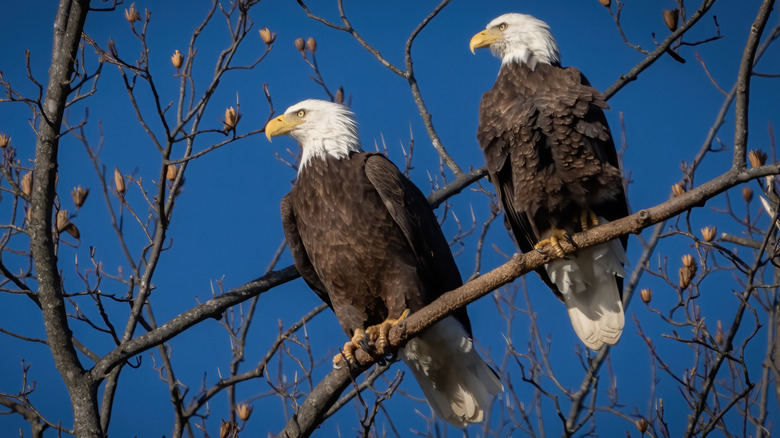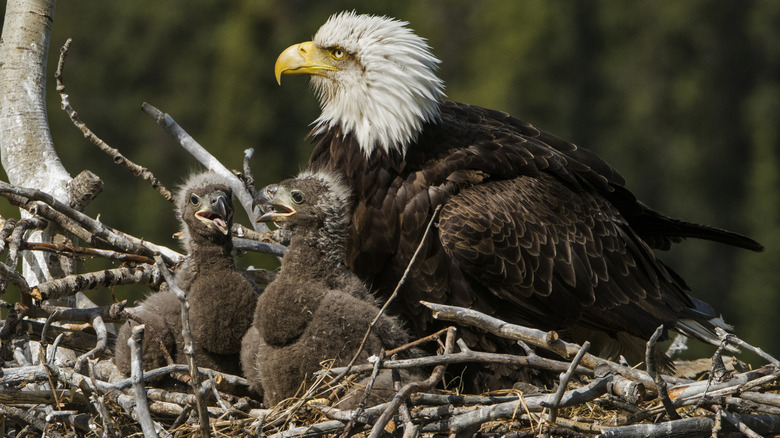Here's What It Would Be Like Having 2 Bald Eagles As Parents
What comes to mind when you see a photo of a bald eagle? Perhaps it's how eagles are one of the biggest birds of prey with a wingspan that makes you feel small. Or, maybe it's how their feathered legs humorously look like jogging pants? You probably don't think of these winged creatures as parents, but of course, any living thing that reproduces becomes a parent. One of the many admirable traits of these birds is that bald eagles mate for life. This equates to both parents playing a role in caring for their eaglets and preparing them to be independent.
Although bald eagles engage in some odd and even off-putting activities involving their offspring, humans could learn a thing or two about their other parenting methods. In fact, if children had two bald eagles as parents, they'd likely be more equipped for adulthood at a younger age than they'd be with human parents; bald eagles shift their parenting priorities after their eaglets reach a certain age in a way that benefits the eaglets.
The way bald eagles share parenting duties, such as hunting, feeding their young, and protecting the nest, also offers valuable lessons for human parents. This is especially relevant today, since many parents struggle with unequal distribution of child-rearing responsibilities.
What your life would be like as an eagle nestling
If you were a bald eagle nestling, you'd rely entirely on your parents for food and protection for your first few months of life, just as you did as a human child. You'd get to watch as your father provides most of the food for the first few weeks. Then, you'd wait for your mom to tear it into small pieces for you and your siblings. At around the one-month mark, both parents would bring a fairly equal amount of food, and during the last couple weeks in the nest, your mother would provide most of it.
Some eaglets fledge their nests as early as 10 weeks of age while others take up to 13. The weeks leading up to this period would be the equivalent of a human teenager who's just graduated high school and making plans to move out. As a human teen, you'd likely be used to cleaning your room, or your parents would do it for you — and resent you for it. As an eaglet, however, there would be no parental expectation for you to clean your nest.
That's because eagle parents take a different approach to cleaning. Bald eagles cover the messy, fetid nests with fresh leaves, instead of removing debris. Nests can become soiled with old, rotting food particles and sometimes even feces and maggots. Of course, birds don't have the luxury of a vacuum cleaner or air freshener like we do, but they do their best to make the aerie comfortable for their nestlings.
What human parents can learn from bald eagles
Eagles can learn from humans when it comes to cleanliness, but humans can glean from eagles in the area of sharing duties and preparing their young for adulthood. A 2023 Pew Research Center study on gender and parenting found that most mothers say they do more than their spouse or partner to meet their children's needs. In addition, data from the 2022 U.S. Census Bureau reveals that a whopping "80% of one-parent family groups were maintained by a mother."
These stats contrast compared to how bald eagles parent. Remember, these birds meet their nestlings' primary needs fairly equally. They also both help during the incubation period and other periods during nesting. Bottom line? Bald eagle parents maintain a healthy partnership and both play an active role in caring for their young, but not all human parents do the same for theirs.
Bald eagles also encourage independence in their nestlings to the point of withholding food to give them more incentive to test their wings. Most Americans, on the other hand, feel that parents handle duties for their young adult children that they should be handling themselves. If you had two bald eagles as parents, not only would you have equal partners raising you; you'd also have parents who prioritize empowering you to be independent. Want to read more interesting things about eagles? Check out a rare eagle that appeared in North America for the first time or the rare bird of prey saved in Iowa.


